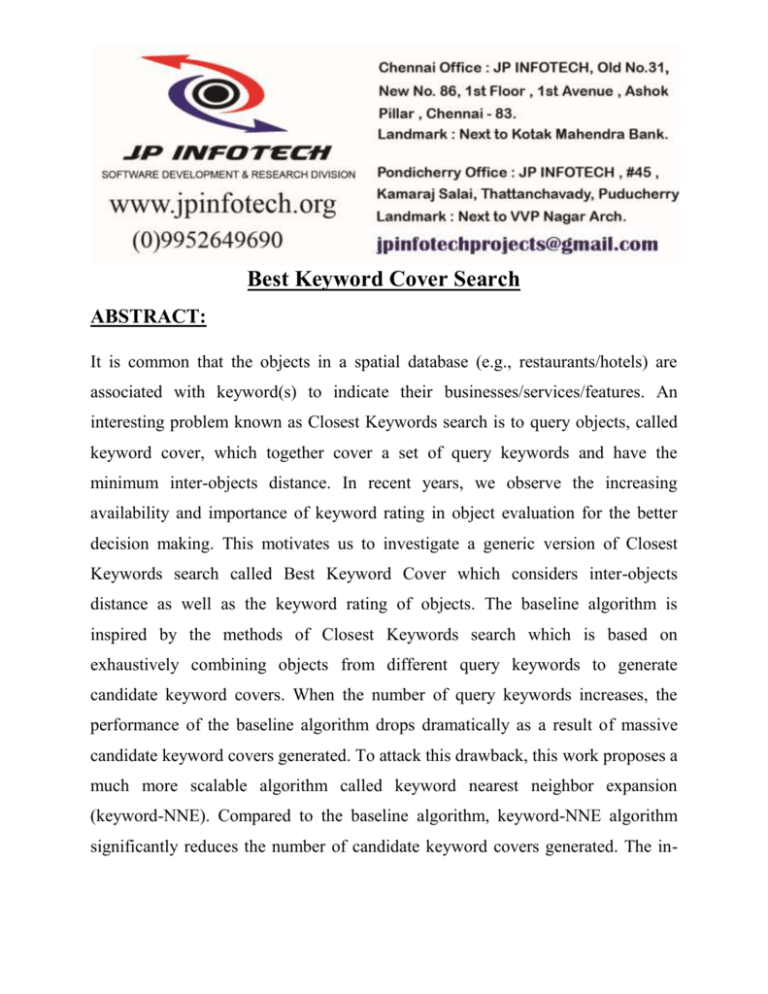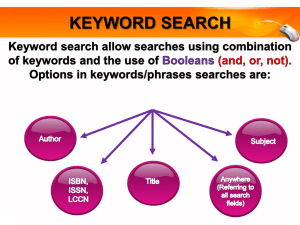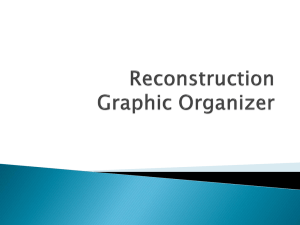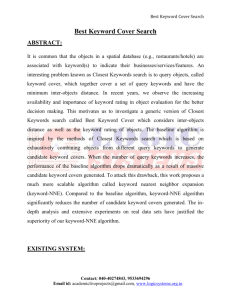Best Keyword Cover Search
advertisement

Best Keyword Cover Search ABSTRACT: It is common that the objects in a spatial database (e.g., restaurants/hotels) are associated with keyword(s) to indicate their businesses/services/features. An interesting problem known as Closest Keywords search is to query objects, called keyword cover, which together cover a set of query keywords and have the minimum inter-objects distance. In recent years, we observe the increasing availability and importance of keyword rating in object evaluation for the better decision making. This motivates us to investigate a generic version of Closest Keywords search called Best Keyword Cover which considers inter-objects distance as well as the keyword rating of objects. The baseline algorithm is inspired by the methods of Closest Keywords search which is based on exhaustively combining objects from different query keywords to generate candidate keyword covers. When the number of query keywords increases, the performance of the baseline algorithm drops dramatically as a result of massive candidate keyword covers generated. To attack this drawback, this work proposes a much more scalable algorithm called keyword nearest neighbor expansion (keyword-NNE). Compared to the baseline algorithm, keyword-NNE algorithm significantly reduces the number of candidate keyword covers generated. The in- depth analysis and extensive experiments on real data sets have justified the superiority of our keyword-NNE algorithm. EXISTING SYSTEM: Some existing works focus on retrieving individual objects by specifying a query consisting of a query location and a set of query keywords (or known as document in some context). Each retrieved object is associated with keywords relevant to the query keywords and is close to the query location. The approaches proposed by Cong et al. and Li et al. employ a hybrid index that augments nodes in non-leaf nodes of an R/R*-tree with inverted indexes. In virtual bR*-tree based method, an R*-tree is used to index locations of objects and an inverted index is used to label the leaf nodes in the R*-tree associated with each keyword. Since only leaf nodes have keyword information the mCK query is processed by browsing index bottom-up. DISADVANTAGES OF EXISTING SYSTEM: When the number of query keywords increases, the performance drops dramatically as a result of massive candidate keyword covers generated. The inverted index at each node refers to a pseudo-document that represents the keywords under the node. Therefore, in order to verify if a node is relevant to a set of query keywords, the inverted index is accessed at each node to evaluate the matching between the query keywords and the pseudodocument associated with the node. PROPOSED SYSTEM: This paper investigates a generic version of mCK query, called Best Keyword Cover (BKC) query, which considers inter-objects distance as well as keyword rating. It is motivated by the observation of increasing availability and importance of keyword rating in decision making. Millions of businesses/services/features around the world have been rated by customers through online business review sites such as Yelp, Citysearch, ZAGAT and Dianping, etc. This work develops two BKC query processing algorithms, baseline and keyword-NNE. The baseline algorithm is inspired by the mCK query processing methods. Both the baseline algorithm and keyword-NNE algorithm are supported by indexing the objects with an R*-tree like index, called KRR*-tree. We developed much scalable keyword nearest neighbor expansion (keyword-NNE) algorithm which applies a different strategy. KeywordNNE selects one query keyword as principal query keyword. The objects associated with the principal query keyword are principal objects. For each principal object, the local best solution (known as local best keyword cover lbkc) is computed. Among them, the lbkc with the highest evaluation is the solution of BKC query. Given a principal object, its lbkc can be identified by simply retrieving a few nearby and highly rated objects in each non-principal query keyword (two-four objects in average as illustrated in experiments). ADVANTAGES OF PROPOSED SYSTEM: Compared to the baseline algorithm, the number of candidate keyword covers generated in keyword-NNE algorithm is significantly reduced. The in-depth analysis reveals that the number of candidate keyword covers further processed in keyword-NNE algorithm is optimal, and each keyword candidate cover processing generates much less new candidate keyword covers than that in the baseline algorithm. The proposed keyword-NNE algorithm applies a different processing strategy, i.e., searching local best solution for each object in a certain query keyword. As a consequence, the number of candidate keyword covers generated is significantly reduced. The analysis reveals that the number of candidate keyword covers which need to be further processed inkeyword-NNE algorithm is optimal and processing each keyword candidate cover typically generates much less new candidate keyword covers in keyword-NNE algorithm than in the baseline algorithm. SYSTEM ARCHITECTURE: USER RATINGS User Search Query Nearest Search USER RATINGS LOG Keyword Rating Query Results USER PROFILES SYSTEM REQUIREMENTS: HARDWARE REQUIREMENTS: System : Pentium IV 2.4 GHz. Hard Disk : 40 GB. Floppy Drive : 1.44 Mb. Monitor : 15 VGA Colour. Mouse : Logitech. Ram : 512 Mb. SOFTWARE REQUIREMENTS: Operating system : Windows XP/7. Coding Language : JAVA/J2EE IDE : Netbeans 7.4 Database : MYSQL REFERENCE: Ke Deng, Xin Li, Jiaheng Lu, and Xiaofang Zhou, “Best Keyword Cover Search”, IEEE TRANSACTIONS ON KNOWLEDGE AND DATA ENGINEERING, VOL. 27, NO. 1, JANUARY 2015.






